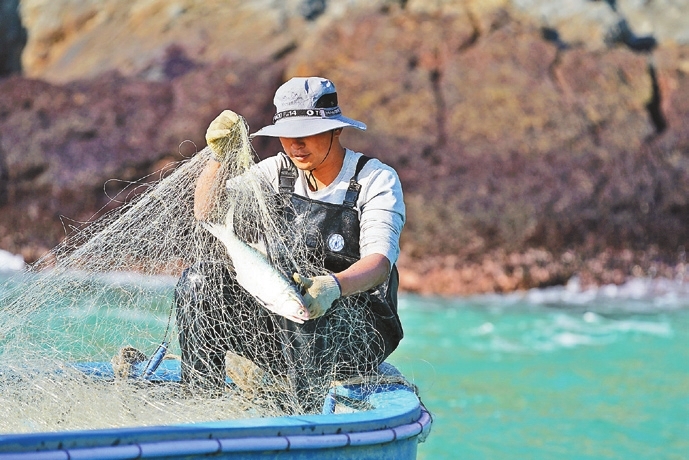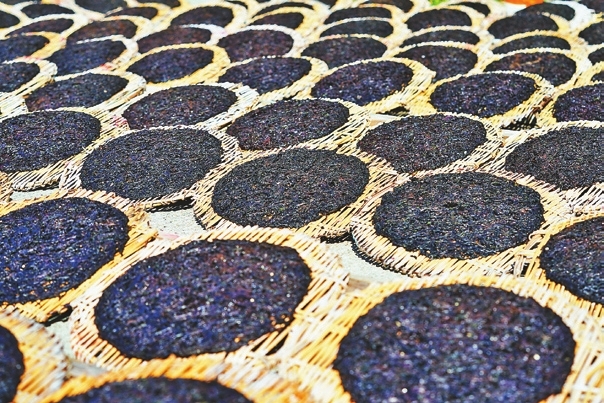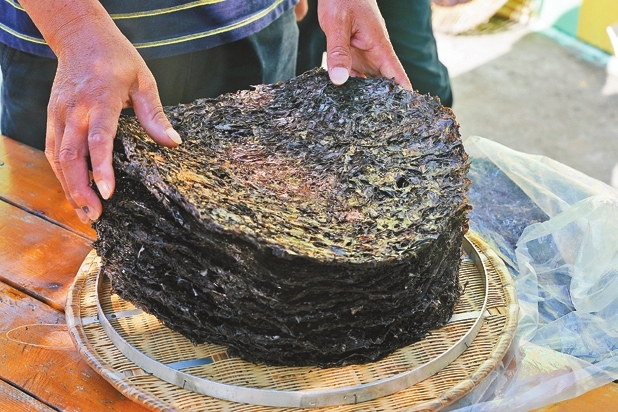








Yang Mei yangmei_szdaily@163.com At 9 a.m. on Dec. 11, a sunny, breezy and calm day, two of our cameramen and I took a speedboat from Dongchong beach in Dapeng New Area. About 15 minutes later, we arrived at Hai Chai Jiao and saw some local fishermen in groups of three and four already in the race against the rising tides and pounding waves harvesting laver seaweed, a local delicacy that is often used in soup with eggs in Chinese cuisine. It is also used in Japan to make delicate sushi sheets. Hai Chai Jiao is located at the eastern end of Dapeng Peninsula, possessing magnificent yet treacherous terrain. Dressed comfortably and carrying small, self-made, shovel-like tools and bamboo baskets to house their catches for the day, the fishermen leaped effortlessly across the rocks as the waves crashed in. According to our boatman Huang Weijian, who himself is a laver seaweed collector, seaweed has its best harvests in November and December. Hai Chai Jiao’s coastline of about five kilometers provides a very favorable environment for high-quality laver seaweed growth. “Laver seaweed likes cold, large waves, for they bring in more and richer algae, which is indispensable for the laver seaweed to grow and thrive,” Huang said. Laver seaweed’s unique living environment makes harvesting them extremely risky. Huang told us that he was once washed away by the sea twice during a single harvest. His feet got badly injured, and some green hands have even lost their lives. Nonetheless, fishermen in Dongchong Village are flocking to the coast to pick the sea vegetable for nothing more than its distinctive flavor. Some give it to friends as holiday presents, but most of them sell it as an additional means of income. Zhang Zhongke is among some 40 fishermen in Dongchong who still go out to the sea for laver seaweed. Zhang works alongside his friend Ling Jianzheng. At noontime they return home for a lunch break during which they can process their morning catch. Zhang told the Shenzhen Daily that fishermen usually work in pairs or groups for safety reasons and efficiency. Rows of laver seaweed displayed neatly in disks, the pair’s “spoils” for the past two days, were seen being aired out in the sun when we got to Zhang’s home at around 11 a.m. The middle-aged man told us that 20 or so disks of dried laver seaweed makes 1 jin (500 grams), and 1 jin of laver seaweed is priced at 800 yuan on the market, whereas the farmed ones are only 30 to 40 yuan per jin. Despite the high price, laver seaweed sells very fast and is very popular among locals for its great taste and nutritional value. “On a good day we can have 40 jin of fresh laver seaweed, which is 5 jin when dried,” Zhang said. “Before airing it, we usually get rid of unwanted things like shells and rinse it with clean, fresh water.” People in Dongchong know perfectly well how to make a living from what the land and sea have given them. In addition to collecting laver seaweed in winter, villagers in Dongchong mainly make a living by turning their houses into B&Bs in peak tourist seasons, processing seafoods like abalones or keeping honeybees in surrounding mountains. According to Ling Beien, former head of the Dongchong Village Committee, there are 185 households with a residential population of 650 villagers, of which 50 or so households are running B&Bs, which constitutes a major source of residents’ income. | 
